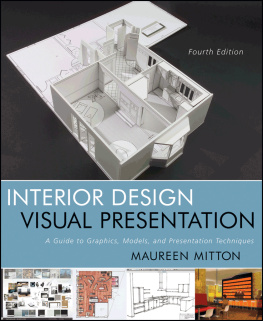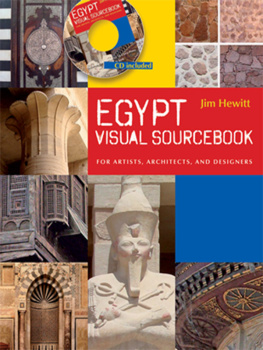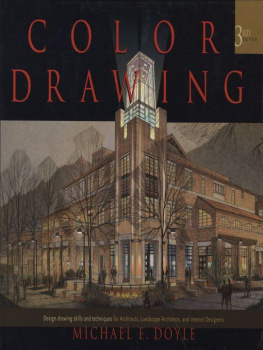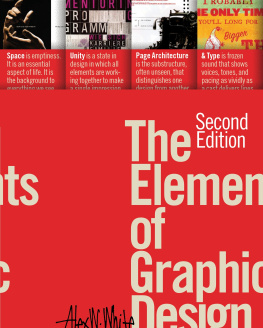ENTOURAGE
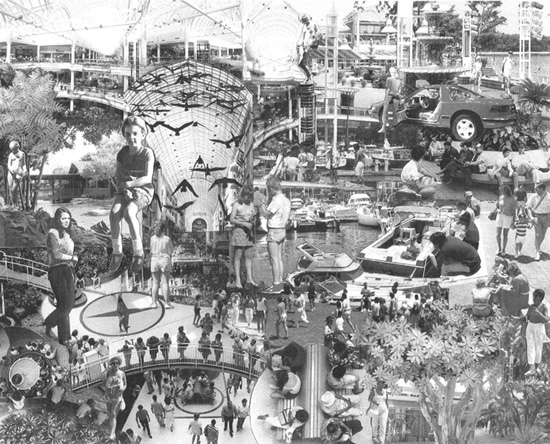
ENTOURAGE
A Tracing File and Color Sourcebook
5th Edition
Ernest Burden


Copyright 2011, 2003, 1996, 1991, 1981 by The McGraw-Hill Companies, Inc. All rights reserved. Except as permitted under the United States Copyright Act of 1976, no part of this publication may be reproduced or distributed in any form or by any means, or stored in a database or retrieval system, without the prior written permission of the publisher.
ISBN: 978-0-07-175455-2
MHID: 0-07-175455-5
The material in this eBook also appears in the print version of this title: ISBN: 978-0-07-175454-5, MHID: 0-07-175454-7.
All trademarks are trademarks of their respective owners. Rather than put a trademark symbol after every occurrence of a trademarked name, we use names in an editorial fashion only, and to the benefit of the trademark owner, with no intention of infringement of the trademark. Where such designations appear in this book, they have been printed with initial caps.
McGraw-Hill eBooks are available at special quantity discounts to use as premiums and sales promotions, or for use in corporate training programs. To contact a representative please e-mail us at bulksales@mcgraw-hill.com.
TERMS OF USE
This is a copyrighted work and The McGraw-Hill Companies, Inc. (McGraw-Hill) and its licensors reserve all rights in and to the work. Use of this work is subject to these terms. Except as permitted under the Copyright Act of 1976 and the right to store and retrieve one copy of the work, you may not decompile, disassemble, reverse engineer, reproduce, modify, create derivative works based upon, transmit, distribute, disseminate, sell, publish or sublicense the work or any part of it without McGraw-Hills prior consent. You may use the work for your own noncommercial and personal use; any other use of the work is strictly prohibited. Your right to use the work may be terminated if you fail to comply with these terms.
THE WORK IS PROVIDED AS IS. McGRAW-HILL AND ITS LICENSORS MAKE NO GUARANTEES OR WARRANTIES AS TO THE ACCURACY, ADEQUACY OR COMPLETENESS OF OR RESULTS TO BE OBTAINED FROM USING THE WORK, INCLUDING ANY INFORMATION THAT CAN BE ACCESSED THROUGH THE WORK VIA HYPERLINK OR OTHERWISE, AND EXPRESSLY DISCLAIM ANY WARRANTY, EXPRESS OR IMPLIED, INCLUDING BUT NOT LIMITED TO IMPLIED WARRANTIES OF MERCHANTABILITY OR FITNESS FOR A PARTICULAR PURPOSE. McGraw-Hill and its licensors do not warrant or guarantee that the functions contained in the work will meet your requirements or that its operation will be uninterrupted or error free. Neither McGraw-Hill nor its licensors shall be liable to you or anyone else for any inaccuracy, error or omission, regardless of cause, in the work or for any damages resulting therefrom. McGraw-Hill has no responsibility for the content of any information accessed through the work. Under no circumstances shall McGraw-Hill and/or its licensors be liable for any indirect, incidental, special, punitive, consequential or similar damages that result from the use of or inability to use the work, even if any of them has been advised of the possibility of such damages. This limitation of liability shall apply to any claim or cause whatsoever whether such claim or cause arises in contract, tort or otherwise.
CONTENTS
Acknowledgments
This edition represents the efforts of many people on the production side, as well as those on the artistic side mentioned in the credits for drawings. Special thanks to my editor, Joy Bramble, who suggested a new and updated look for this edition and the addition of color images, and to Steve Chapman, publisher, McGraw-Hill Professional, who encouraged the revision. Pamela Pelton expertly handled the production of this edition, as she has done with previous editions, and Stephen Smith edited the text and assisted in coordination with the printer. My son, Ernest III, provided technical advice whenever needed, which was often. A very special thanks to my wife, Joy, for her untiring masking and production of the final files for the color images, and for her assistance and encouragement throughout the final production process of this edition.
Drawing Credits
This book represents a unique combination of artistic talent and photographic technique. I am grateful for the artistic contribution of my daughter Analisa, my son Ernest III, and my friend Brian Burr, whose work appeared in all previous editions of this book. I am also thankful for the talented work of the late Robert Mcllhargy and his wife Lori Brown, who supplied many splendid examples featuring the use of entourage in professional renderings. Thanks also to all the talented delineators whose rendering examples enhance this edition. They are: J. Henderson Barr, Stanley Doctor, Robert and Anna Fisher, Richard Gardner, Gordon Grice, Andy Hickes, Ron Love, Mark DeNalovy Rozvadovski, and Walter Thomason.
To obtain material from the disk that accompanies the printed version of this eBook, please .
Material from the disk that accompanies the printed version of this eBook may be obtained from McGraw-Hill Professionals MediaCenter at http://mhprofessional.com/mediacenter.
Some material may require a desktop or laptop computer for full access.
Enter this eBooks ISBN and your e-mail address at the MediaCenter to receive an e-mail message with a download link.
This eBooks ISBN is 978-0-07-175455-2.
PREFACE
Most architecture schools offer a disproportionate number of courses on the basics of design and not enough attention to the presentation of those designs. Hence, when students become licensed professionals, they find that they must rely on outside architectural artists and professional delineators to assist them in this vital area. Most professional delineators begin their training in architecture and later specialize in presentation drawing, having acquired the skill for drawing along the way in their job experience.
An artists sketch of a scene in nature or buildings in their surroundings is a personal interpretation, and the skill in perceiving the subject or object and the technique of drawing used are the only criteria for its success. This is not so with an architectural illustration. Producing a perspective view is a technical matter; either it is right or it is wrong. The building or interior view must be accurately depicted from one particular vantage point in space, and there are several methods that can accomplish this.
Perspective views can be sketched without the use of drawing instruments, but they serve only as an approximation, mainly for viewpoint selection. True perspectives are mechanically plotted using the principles of perspective visualization and projection developed during the Renaissance, or by using perspective software programs in the computer. Once the architectural components of the project are set up in the computer, it is possible to display and print out an infinite number of perspective viewpoints, including some that are difficult to obtain using the orthographic projection method. Perspective layouts can also be produced by building stage-set props or scale models and photographing them, which produces an accurate representation and viewing possibilities from an infinite number of vantage points. However, the end product of all these different approaches must be the same; that is, a realistic representation of how the project will appear when it is actually constructed within its surroundings.
Next page



